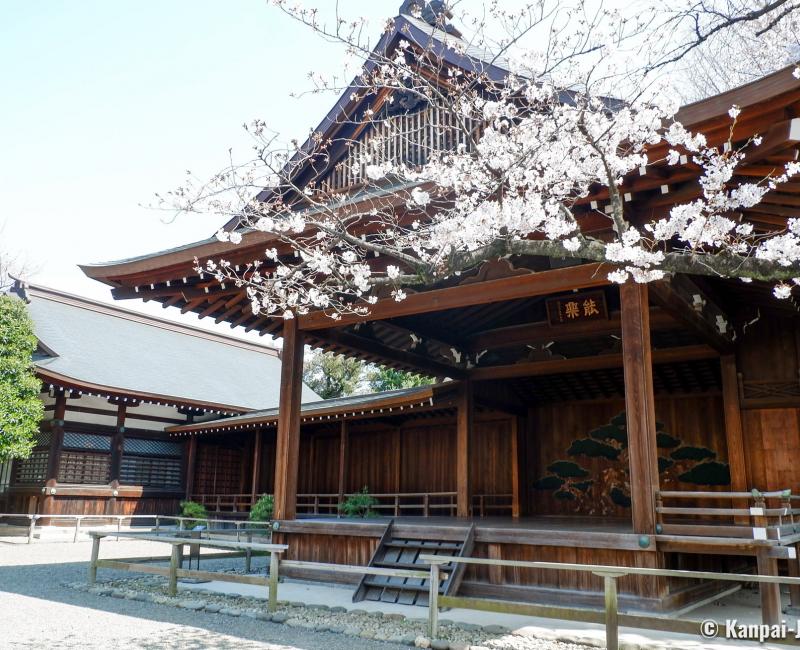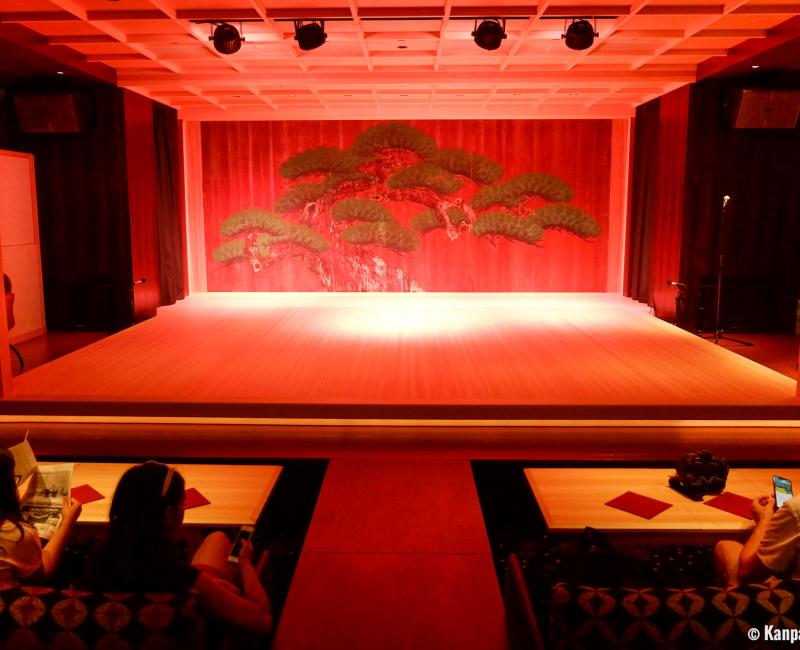Noh Theater
The Oldest Dramatic Art of Japan
Noh (能) or Nôgaku (能楽) is one of the most ancient dramatic arts in the world and the oldest in the Japanese archipelago: its origins have been traced back to the 7th century. Noh theater was inscribed in the UNESCO World Heritage List in 2008 and some of the actors are considered as Japanese Living National Treasures. Today, there are nearly 70 theaters and about a thousand professional actors in the country.
Unlike its counterpart Kabuki theater, eccentric and even exuberant, Noh theater emphasizes subtleness and suggestion. No gaudy make-up or powerful voices here, but rather chorus and lyrical singing, interspersed with dances and declamations.
The origins of Noh drama
The present-days Noh was shaped in the late 14th century, but it stems from the sacred Shinto rituals and the traditional country dances of the 7th century named kagura (神楽) that were performed to attract the gods’ goodwill and pray for good harvests. Over time, and with the rising prevalence of Buddhism, these dances lost prestige, their codes were changed, and this art was transformed and renamed as sangaku (散楽).
It was during the Muromachi period (1336-1573), that the art of Noh took its final form. Under the authority of shogun Ashikaga Yoshimitsu, two actors, Kan’ami (1333-1384) and his son Zeami (1363-1443), completely remodeled the form of sangaku upon which they established the rules of Noh. They decided to take direct inspiration from Zen, to write new texts and imagine stricter rules. The duet transformed a plebeian art into a refined art for the Japanese elite.

What are the characteristics of Noh drama?
The main features of Noh theater are the search for simplicity and symbolism, expressed in particular in the places where the dramas are played.
The stage and the placement of the actors
The theater, usually small, hosts a rather small-scale stage, which is covered by a roof -even indoor stages- as a reminder of the times when Noh was mainly performed outdoor in shrines’ grounds.
Most of the show is performed on a squared platform of about 6 meters (19ft.) wide, connected to the backstage by a raised walkway of about 6 meters long: the hashigakari (橋掛かり). It is lined with 3 symbolic pine trees that are used as locators by the actors and serve to induce perspective effects. The stage background is also ornamented with a painted pine tree.
Musicians (one flutist and three percussionists) and the actors' assistants take place at back of the stage. An eight singers chorus is placed on the edge of the stage, opposite to the backstage.
Most of the times, there are only two actors on stage with very specialized functions:
- The supporting role (wakiyaku 脇役) is the first character to enter the stage, with a bare face. He settles near the right front pillar, from where he will narrate the story and converse with the other characters. He normally does not sing neither dance, but only declaims. He represents the human beings.
- The main role (shite シテ or shuyaku 主役) is the focus of the audience thanks to his singing, dances, and declamations. He generally wears a mask and luxurious costumes, notwithstanding the social class of the character. He represents all non-human characters (ghosts, demons, etc.)
Other actors, such as tsure (ツレ) or tomo (とも) occasionally come as supports for waki and shite, but always in a reduced number.
Under the stage platform, a particular sound box system with huge jars is laid out to amplify the sound of the shite’s stomps on the wooden floor, which is one the characteristics of Noh drama acting.
Due to the stage’ s specific layout, there are 3 seats categories, determined by the visibility they provide on the performance:
- Facing the stage (shômen 正面): spectators have an overall view of the stage; it is the best category.
- The left of the stage (wakishômen 脇正面): spectators are seated between the hashigakari and the stage. This location is enjoyed by those who like to be the closest to the actors.
- The angle of the stage (nakashômen 中正面), between the two other seat categories, is considered the less interesting seating as the view is partially obstructed by one of the pillars sustaining the stage’s roof.

The masks
A Noh drama is first and foremost characterized by masks. They are made of cypress wood and are about twenty centimeters (~7,8 inches) long. They are almost exclusively worn by the shite and his tsure to symbolize the supernatural quality of their characters. The masks are smaller than the proportions of the human face and placed to let the chin show, as a way of enhancing the fantastic aspect. There are 5 main types of masks:
- The woman’s mask 😷 (onnamen 女面) a face modeled according to the idealized beauties of the Heian period: white skin, brows painted on the forehead, red lips, and black teeth.
- The man’s mask (otokomen 男面), with a fair complexion, raised brows and flat nose, often underlined by a fine moustache.
- The old man’s mask (okinamen 翁面) with an extremely wrinkled face and a long white goatee.
- The spirit’s mask (onryômen 怨霊面) with a distorted face, protruding eyes, the mouth opened on fangs and the head often crowned with horns. It represents ghosts or restless spirits.
- The demon’s mask (kimen 鬼面) with golden or red hues, big eyes and the mouth often contracted in a threatening grin showing the teeth. It represents supernatural beings such as tengu 👺.
These 5 main types are said to be broken down into no less than 180 different versions to match the characters’ variety. Some masks have been passed down from generation to generation for 700 years.
The masks have an intrinsically fixed expression, but through codified and precise gestures, by playing with the light, actors succeed in giving them life and convey an emotion to the audience.
What is a Noh play like?
The Noh theatre repertoire includes about 240 plays, derived from the Japanese classical literature or old legends. It is fixed since the 17th century on five main themes, that also constitute the five acts of a play, always performed in the same order:
- Kamimono (神物) or "Gods’ Noh": the shite interprets a god appearing under the guise of an elderly man. He proceeds to sing the kamiuta (or shinka 神歌) song with a combination of dance and Shinto ritual.
- Shuramono (修羅物) or "Warriors’ Noh" is usually structured by the encounter of a Buddhist monk (played by the waki) and the soul of a warrior of the past, lost in the reincarnation cycle (played by the shite). The texts refer to ancient epic chronicles narrating the death and distress of the great warriors’ spirits.
- Kazuranô (鬘能) or "Women’s Noh", where the tale of the waki generates the apparition of a woman who lived a tragic fate, in a structure similar to the Shuramono’s. The Tale of Genji and The Ise Stories are the main sources. This third act is considered as the most emotionally intense and the most important.
- Zônô (雑能), the Noh interlude, is not a predefined part per se, but usually the texts played are intended to be more entertaining and less "serious," but tragic or epic stories can also be played.
- Kirinô (切能), lastly, the "Demons’ Noh," are plays where demons are not necessarily evil, and often tell the encounter of a nobleman with a good omen supernatural being, such as a creature of the Buddhist hell. The theme is usually lighter in consideration for the fatigue of the audience.
The five acts, played over a day, are interspersed with Kyôgen (狂言) jester interludes. Each act is divided into scenes, between which skits, the ai-kyôgen (間狂言), related to the main story, allow the shite to change costume. The first act is preceded by a play named wakinô mono (脇能物), that is not modern Noh drama but rather a religious act usually played for the New Year and / or at the beginning of each play.
What about Noh theater today?
Nowadays, Noh theater tends to be declining. The texts and the acting have not changed for 700 years, so it is a difficult art, even for a Japanese audience. Noh theaters spend more time closed than opened, a terrible consequence due to the lack of interest from the Japanese for this age-old art. Even more as they mainly rely on the tickets’ revenue, as the Japanese states does not subsidize Noh theater as much as it does other traditional arts such as Kabuki or Bunraku.
The new generations also regret that women were not usually allowed to practice this art. Nowadays, less than 15% of the roles are played by women and they are still barred from playing the main one.
However, tourism growth in the archipelago gives Noh theater a breath of fresh air and efforts are made for its democratization, such as Japanese and English surtitling of the plays, or the publishing of information materials, mainly for a Japanese audience.
Some Noh families open to the larger public with Noh theater workshops as leisure activity.
One of the challenges for the Noh’s great families in the next years will be to make Noh, an art that developed to be elitist, popular again without losing its identity.

How to attend to a Noh play and how much is it?
Among the many Noh theaters, the most famous is probably Kanze Nôgakudô at Ginza Six in Tokyo. It indeed belongs to one of the most iconic Noh family, the Kanze, who are Zeami’s direct descendants, and it is currently managed by its 26th heir. One can also go to (non-exhaustive list):
- Cerulean Tower Noh Theater in Shibuya, the theater is open to the visit besides Noh performances.
- National Noh Theater in Sendagaya (booking in English available).
- Yoyogi Nobutai in Yoyogi, whose stage is partially outdoor.
- Yamamoto Nôgakudô in Osaka, near the castle, that also offers theater workshops; and,
- Nagoya Nôgakudô, near Nagoya castle.
Tickets are quite affordable: from ~US$20.90 to ~US$55.73 per person on average for a play depending on the seat category. Bookings are to be made at the theater, on the phone or on site, most of the time in Japanese.
Noh theater can also be enjoyed as a part of a broader experience along with:
- Gastronomy at Suigian restaurant in the heart of Tokyo’s Nihombashi chic district, where it is possible to enjoy various traditional arts performances, including Noh, along with a high-end menu.
- Japanese spirituality, during the Noh Theater Festival (Tokasai goshinnô 桃花祭御神能) held every year on three days in mid-April in Itsukushima shrine. The plays performed are intended to be closer to the Shinto rituals but still follow the general rules of Noh.
All year around, it is at least possible to admire outdoor Noh stages, in their original locations, namely temples and shrines. For example:
- In Yasukuni-jinja shrine in Tokyo,
- In Usa-jingu shrine in Oita (Kyushu),
- In Chuson-ji temple in Hiraizumi, Iwate prefecture,
- Etc.
Warning: Noh drama is quite difficult to understand, texts are in old Japanese and despite the modern translation provided before the play, and more often than not English translation is not available. Moreover, it is not recommended to attend a Noh play with young children, as the acting is quite slow and peculiar, and plays last several hours.


